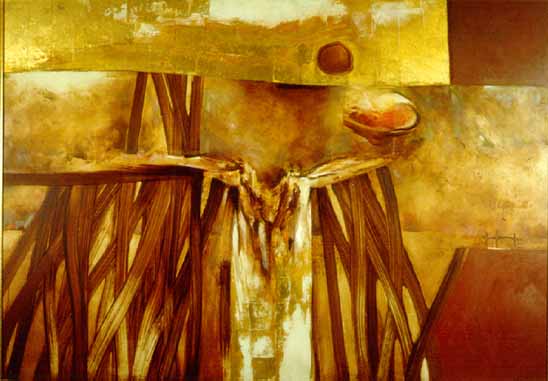Judith MASON
from the
PELMAMA PERMANENT ART COLLECTION

"Gabriel", 1968 - Oil/mixed media on board - 122x183 cm
PELMAMA Register MAMS JMAS 68/02
Work donated in 2009 to the Pretoria Art Museum, Pretoria (loaned since 1992)
Provenance:
The Haenggi Foundation Inc., Johannesburg
Private Coll.: Caroline M. Haenggi - donated by the artist as a wedding gift
Work exhibited:
University of the Witwatersrand, Johannesburg (Art & Artists of South Africa), 1983
Standard Bank Gallery, Johannesburg – October/December, 2008
Sasol Art Museum, University of Stellenbosch, Stellenbosch – January/March, 2009
Work catalogued or illustrated:
ARTLOOK 22, Johannesburg, September, 1968, p. 8, ill.
Art & Artists of Southern Africa (Berman), 1970, p. 190, ill.
The story of South African Painting (Berman), 1975, p. 237, ill.
University of the Witwatersrand, Johannesburg (Art & Artists of South Africa), 1983 (cat.)
Art & Artists of Southern Africa (Berman), 1983 + 1994, opposite p. 287, ill.
Painting in South Africa (Berman) (Southern Book), 1993, col. pl. 83, ill.
Judith Mason: a prospect of icons (The Standard Bank of SA Ltd.) (2008) – ISBN 978-0-620-41289-6 – p. 32
Note: also recorded as "Archangel Gabriel"
"Gabriel" is one of the major canvases by Judith Mason, a large-scale work, the theme of which is the Annunciation. It demonstrates the fineness of her technique and the confidence with which she orders the abstract elements of composition. Its symbolism, however, is defined in figurative terms. The Archangel Gabriel is portrayed as a headless figure, symbolising his role as the mindless messenger of God. Gold leaf has been employed fragmentarily on the angel's body and solidly in the upper zone, harking back to the Mediaeval convention of representing divinity and heaven with the use of gold. Gabriel's outstretched arms prefigure the Crucifixion and the suggestion of early landscape around him symbolises the coming of Calvary" (Esmé Berman)
This page last updated 21st June, 2016